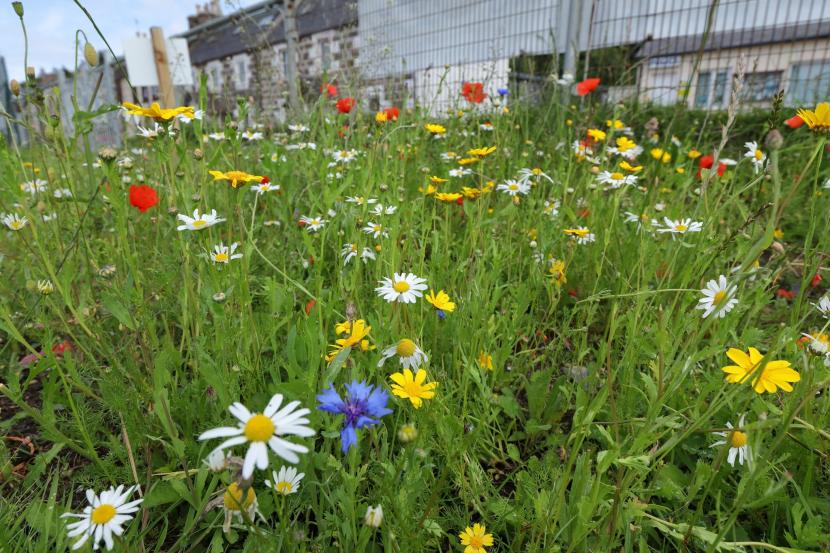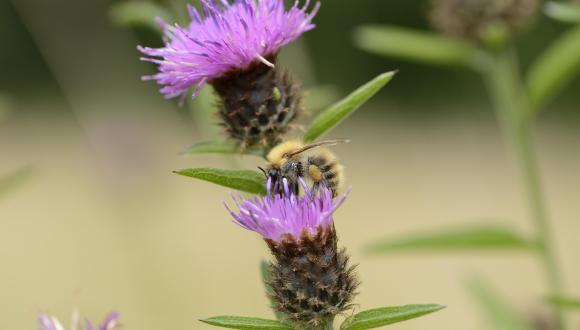Business sites and pollinators
There is considerable potential for business sites to be pollinator-friendly. But where do you start? This document suggests actions that businesses could take to help pollinators, but please get in touch if you would like to discuss ideas and actions in more detail.

A good starting point is to consider what you already have. A short exercise to take stock of your grounds will let you know what is of pollinator value. Good elements would be areas of wildflowers, hedges, flowering trees and shrubs.
Most flowering plants are essential food sources for pollinators. These can be from wild plants, hedges, grassy areas, trees, shrubs, ivy and even bramble. Our Planting for Pollinators guide will help you identify pollinator-friendly plants, and a phone app like PlantNet can be a useful aid. If you feel unconfident in identifying the plants, you could ask an ecologist or environmental group to help with the task.
Don’t write off areas of uncut grass. Often these are home to beneficial plants such as bird’s-foot trefoil, clover, vetches and knapweed. Protecting these native wildflowers is an effective, and indeed cost-effective, way to help pollinators. Reducing mowing will certainly help plants such as these flourish.
Perception matters. Leaving areas of grasslands uncut until autumn can create an untidy look. If you are concerned that some employees or customers may perceive these areas as messy, you could use our free Managed for Wildlife signs to persuade them of the value of these area to nature.
If you have a large area of grass, you can reduce cutting by mowing paths through the area. You should take the cuttings away and not simply spread them over to avoid returning nutrients to the soil and inadvertently supressing the wildflower growth you are looking to encourage.
You may remove potentially difficult plants such as docks, nettles, and ragwort. Whilst some of these are good for pollinators, they can make the area less enjoyable. Removal by hand is the preferred option, do not resort to herbicides.
Having considered managing your space for food resources, you may want to spend some time observing which pollinator species are using your site. There are many useful guides to help you. Indeed, taking part in one of the UK Pollinator Monitoring Scheme FIT Counts is a fun and practical way to do this.
If you decide to enhance your site by planting, you should embrace native plants. Local plants have evolved alongside local pollinators, and are proven to thrive in local conditions. Plants such as begonias and daffodils may add a splash of colour, but they are no good for our pollinators as they provide little or no pollen and nectar. If you want to plant bulbs, then snowdrops, crocus, and grape hyacinth are good choices. If you are usure what to plant, then consult our Planting for Pollinators guidance where you will find advice on flowers, shrubs and trees, as well as a steer on what will flower in each season.
Hedgerows are a major asset for pollinators. They offer nesting sites in the tussocky grass at their base, provide corridors for insects to travel along, and lots of food in one place. Hawthorn and blackthorn are popular hedgerow plants and provide food in early spring, just when resources are scarce. Dog rose, ivy and bramble are also assets for pollinators and wildlife.
Hedges do require some management, but there are many guides you can find on the internet. Main considerations are infrequent cutting, and no cutting during bird nesting season.
Containers and hanging baskets are a great solution if your business does not sit on a large area of land. The same planting advice regarding native plants and bulbs applies.
You might be tempted to add honeybee hives to your site would be helping pollinators. But this isn’t the case. Honeybees are managed pollinators, under no threat, and will complete with wild pollinators for food.
Moving on from the matter of food, there are options to provide pollinators with nesting sites. As you might imagine, different species have different nesting needs.
Most bumblebee species will nest in the tussocky grass beneath hedges or in long grass. Solitary bees nest in the ground, with a preference for south-facing bare earth. Cavity-nesting solitary bees will nest in holes and plant stems.
Pesticides are among the many threats our pollinators face .You should avoid or at least reduce the use of these products as they can disorientate, harm or kill pollinators.
Finally, do let us know how your business is manging a site for pollinators. Your actions could be just the encouragement and inspiration other businesses need to adopt their own pollinator-friendly actions.
Business actions for pollinators … at a glance
- Check what features your site already has to benefits pollinators
- Check which pollinators are using your site
- Consider whether you can have a flower strip
- Consider whether you can reduce your mowing
- Consider whether you have space for a hedgerow
- Consider whether your car park is pollinator-friendly, and if not, could you introduce plants?
- Do you have options to plant trees or shrubs that would benefit pollinators? If space is limited, containers and hanging baskets are alternatives
- Plant native flowers, and consider perennials rather than annuals.
- Do you have any suitable nesting sites for pollinators?
- Reduce pesticide use






